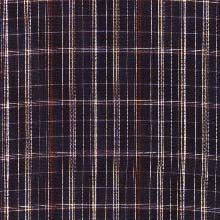Weave (p. 119 )
1. Produced in Takamatsu City, Kagawa Prefecture.
2. Characteristics: Unique cotton fabric with an uneven surface, air permeable and moisture absorbent, giving a dry touch.
3. Uses: Clothing, hand towels, "Noren"(shop curtain), wrapping cloths, sheets, etc.
4. History: "Hota Ori" was invented in 1692 by Tsunekichi Kitagawa, retained weaver of the Takamatsu feudal government. By order of the feudal lord to produce better fabrics than those in other feudal government, he invented silk fabrics which looked a little like crepe fabrics with its raised weft. After that,"Hota Ori" became one of the items used for donating to the Shogunate and the production was made a mystery to be handed down to and monopolized by his descendents. After the Meiji Restoration (1868), Yujiro Kitagawa, one of Tsunekichiユs descendants, made the technique accessible to the public and replaced the silk with cotton. The production was prohibited by the Goods Control Ordinance during WWII, and was revived around 1951 but today, only 2 factories are producing this traditional fabric.



